By Danny White

Lew Arrington was one of the early funny car stars. Lew raced the infamous “Brutus” GTO out of Northern California-based Goodies Speed Shop. A real big block Pontiac powered the converted stock GTO at first, but the Pontiac could not stand the excessive amounts of nitro. A 392 Chrysler with Pontiac stamped on the valve covers replaced the pure Poncho motor. “Brutus” also was the first ride that made “Jungle Jim” Liberman famous, along with the “Samson,” “Hercules,” and “Hairy Canary” funny cars. The GTO ran eight-second times. Arrington built a new Firebird in ’67, while Don Williamson of “Hairy Canary” fame ended up with the much-modified GTO. Future fuel-altered driver Don Trillo crashed the GTO badly enough to end its racing career. (Photo provided by Drag Racing Memories; info from www.draglist.com files)
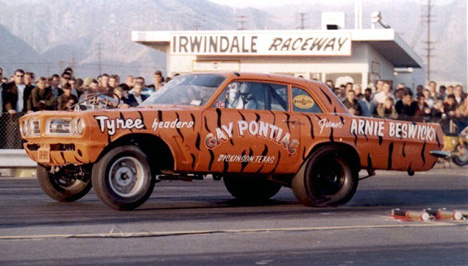
Arnie Beswick might not have been the biggest winner of the sixties, but he did put on a hell of a show. Beswick was a loyal Pontiac racer, though there was a short stint with a Comet A/FX. The “Tameless Tiger” GTO was home built and a little scary, to say the least. Beswick stepped up to blown nitro after beginning with gas at the urging of future funny car star Frank Oglesby. This gave the greater Chicago area three blown nitro funny cars in 1964, including Gary Dyer in the Mr. Norm’s Dodge, Ron Pellegrini’s Super Mustang, and Beswick.
This car was Beswick’s second funny car, replacing a newer GTO that he raced in 1964. Arnie was credited with the first nine-second funny car run. The “Tameless Tiger” was rebuilt to be much lighter than when it first raced in super stock. Beswick later went 8.30s with the car! Arnie Behling later tuned the car before it was parked for good. (Photo provided by Drag Racing Memories; info from www.draglist.com files)
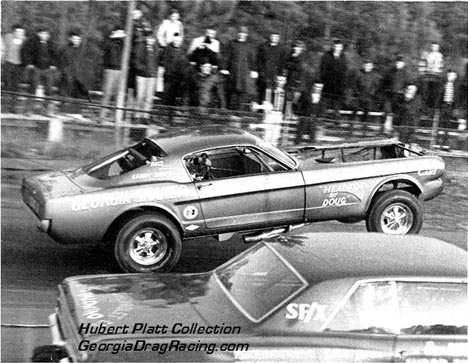
Hubert Platt was known as the “Georgia Shaker” even though he was from the Carolinas. Platt was a moonshine runner before taking on racing. By 1964, Platt was a full-time racer with the Dickie Walter-sponsored “Iowa Shaker” ’65 Falcon. Platt later won the 1967 NHRA Winternationals A/XS title running 8.49 at 147.52, and won the NASCAR Funny Car Class at Summer Championships held at Dragway 42. Platt was well-known for his Fords and his open door burnouts. Hubert’s brother Huston also raced early funny cars, but Huston ran Chevys. Platt quit funny cars to return to Super Stock and later raced Pro Stock. Hubert retired from racing in 1977. (Photo courtesy of David Dilbeck and Hubert Platt; info from www.draglist.com files)
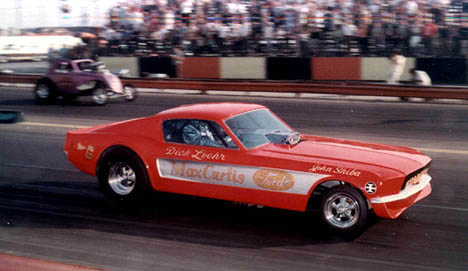
Dick Loehr was one of many funny car drivers based out of Michigan. An engineer by trade, Dick used his job connections to get sponsorship and assistance for his racing operations. In 1967, Loehr had a new Mustang funny car built. The Max Curtis Ford “Stampede” was much lower than most of its competition. The car debuted with a 427 SOHC engine, which later was replaced by a reliable 392 Chrysler Hemi. Loehr ran a best of 7.86 at 189.70 with the car at Orange County. The car was replaced by a new, lighter Mustang in 1969. Dick Loehr eventually left funny cars for Pro Stockers. (Photo provided by Drag Racing Memories; info provided by www.draglist.com)
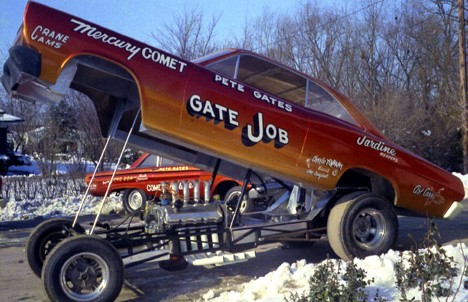
Pete Gates was unknown when he began his funny car career by buying Dyno Don Nicholson’s 1965 Comet. Dyno actually drove his “old car” in the first couple of races while Pete got used to the car. Putting an Art Carr automatic transmission in the “old ’65 Comet” and entering the 1966 Super Stock Nationals, Pete blew away all the big names in funny car racing like Dyno, Fast Eddie Schartman, Beswick, and others to win in his first time out. In 1967, Pete got a new car that consisted of a leftover 1966 Comet fiberglass body on a brand new Logghe chassis. The Gate Job was born.
Pete won a few match races with the Gate Job, including the Memorial Day Olympics of Drag Racing at Great Lakes Dragway. In mid-year, Pete received a new 1967 Comet body. It was all red with two white stripes down the top, unlike the blended, saucy paint job of the original Gate Job. For 1968, Gates got a 1968 Cougar with a new Logghe chassis. Pete ran the Gate Job Cougar into 1969, then hung up his driving gloves. (Photo and text provided by Daryl Huffman)

Fred Goeske came to fame as the second owner of the B&M Plymouth Dealers Barracuda in late 1966. Goeske raced the heavy stock rear-engine car until the end of 1967. In 1968, Fred ordered a new funny car to be built by Ron Scrima and Pat Foster at Exhibition Engineering. The ’68 Barracuda was more traditional than the one it replaced. Still sponsored by the Plymouth Dealers Association of Southern California, Goeske called it the Hemi-Cuda II. The car debuted with a win at Lions Drag Strip, and Goeske was the hottest funny car in Southern California for the next couple of months. Fred ran a best of 7.78 at 191.88 with the car, according to Draglist files. (Photo courtesy of Drag Racing Memories; info from www.draglist.com files)
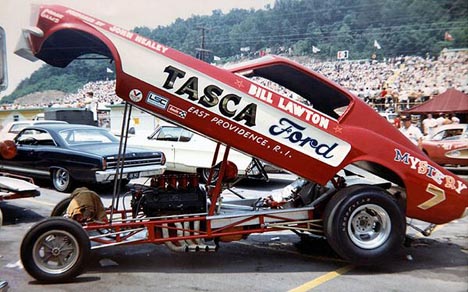
In the sixties, Bill Lawton was Rhode Island’s most successful funny car driver. Teamed with Tasca Ford and tuner John Healey, Lawton won many races in the Super Stock, Factory Experimental, and Funny Car classes. Lawton’s biggest win came at the 1965 NHRA Winternationals, where he won Factory Experimental. The win came in the “Mystery 8,” so dubbed for the goal of running an eight-second time. Bill continued to race with Tasca until the “Mystery 7.” Tasca left drag racing at the same time the Ford Motor Company did. Lawton continued to race funny cars on his own. Tasca recently returned to drag racing with an associate sponsorship for John Force. Tasca also raced a TA/FC with his son, dubbed the “Mystery 5.” (Photo courtesy of Drag Racing Memories; info courtesy of www.draglist.com)
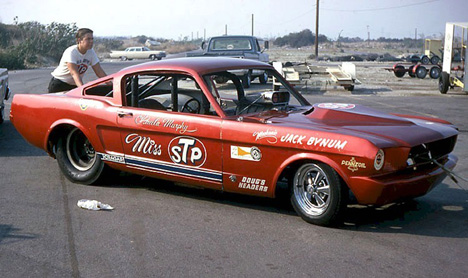
There has been some question about who became the first female funny driver, but we consider Paula Murphy the first. Paula had previous racing experiences with Indy Cars, NASCAR stock cars, and other forms of racing. In 1966, “Fat Jack” Bynum and Murphy teamed up to build a ’66 Mustang funny car called “Miss STP.” The home-built chassis was crude at best, but it had a Dave Zueschel-built 392 Chrysler tuned by Bynum. The uniqueness of a female funny car driver worked for Murphy. Paula was able to get enough bookings to support her as a full-time professional drag racer. The car ran into the eights in the 1967 season. (Photo provided by Mike Ditty; info from www.draglist.com files)
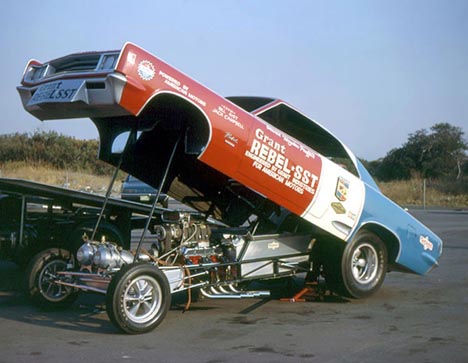
Hayden Proffitt was one of the great racers of the 1960s. Proffitt won many races in Super Stock with a Chevrolet 409, then jumped to a Ford when they gave him a Comet A/FX. Proffitt built a Corvair funny car in 1966. The car began with a top, but it was cut off after the car wanted to lift at speeds. Proffitt got the car to run 8.49. In 1967, Hayden took over the Grant Industries Rebel SST funny car program. Proffitt hired famed Amos Saterlee to tune the large 439 C.I. AMC engine. The problems that the original bunch had with the Rebel continued with Proffitt. The red car ran 8.11 at 180.85 before being retired at the end of 1967.
In 1968, Hayden put the AMC Rebel body on his unused Logghe Stage II chassis. By the end of 1968, AMC dropped out of funny car racing, and Proffitt retired from racing for a few years. Hayden returned to racing with a rocket dragster driven by his son Brad. Proffitt later drove the “Hot Streak” jet dragster. (Photo provided by Mike Ditty; info provided by www.draglist.com files)
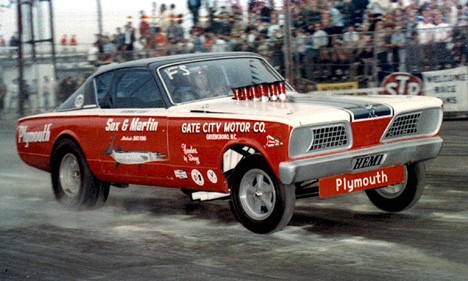
Ronnie Sox only ran funny cars from 1964 to 1966, but he was one of the premier early funny car stars. Sox & Martin began their funny car career with an A/FX Comet. They were one of the American teams that visited England in 1964. In 1965, Sox & Martin got backing from Chrysler and a new altered wheelbase Plymouth. It was in this car that Sox & Martin started running nitro in the tank. In 1966, the evolution of the funny car was happening at such a pace that the cars built in ’64 and ’65 were too old. Sox & Martin sold the old car to Buckeye & Vernon, a team that bought many old Sox & Martin cars.
Sox & Martin then built a new Chrysler-backed Barracuda with an injected 426 Chrysler Hemi backed by a 4-speed transmission. Jake King tuned the injected nitro machine to eight-second times. The Barracuda’s best times were 8.59 at 159. There were rumors of Sox & Martin using the highly volatile rocket fuel hydrazine in match races. When Chrysler stopped backing early funny cars, Sox & Martin went back to Super Stock racing. Ronnie Sox became a legend in drag racing, pioneering and winning in several classes across a 40-year career. These included A/FX, Funny Car, Super Stock, Pro Stock, Pro Modified, and Pro Stock Truck. (Photo provided by Drag Racing Memories; info from www.draglist.com)